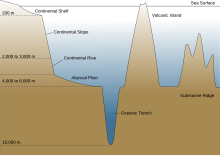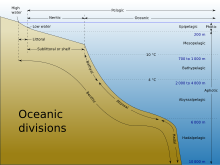
Back سهل سحيق Arabic Abissal düzənlik AZ Абісальныя раўніны BE Абисално дъно Bulgarian গহন সমভূমি Bengali/Bangla Plana abissal Catalan Abyssální plošina Czech Tiefseeebene German Llanura abisal Spanish Abüssaalne tasandik ET


| Aquatic layers |
|---|
| Stratification |
| See also |
An abyssal plain is an underwater plain on the deep ocean floor, usually found at depths between 3,000 and 6,000 metres (9,800 and 19,700 ft). Lying generally between the foot of a continental rise and a mid-ocean ridge, abyssal plains cover more than 50% of the Earth's surface.[1][2] They are among the flattest, smoothest, and least explored regions on Earth.[3] Abyssal plains are key geologic elements of oceanic basins (the other elements being an elevated mid-ocean ridge and flanking abyssal hills).
The creation of the abyssal plain is the result of the spreading of the seafloor (plate tectonics) and the melting of the lower oceanic crust. Magma rises from above the asthenosphere (a layer of the upper mantle), and as this basaltic material reaches the surface at mid-ocean ridges, it forms new oceanic crust, which is constantly pulled sideways by spreading of the seafloor. Abyssal plains result from the blanketing of an originally uneven surface of oceanic crust by fine-grained sediments, mainly clay and silt. Much of this sediment is deposited by turbidity currents that have been channelled from the continental margins along submarine canyons into deeper water. The rest is composed chiefly of pelagic sediments. Metallic nodules are common in some areas of the plains, with varying concentrations of metals, including manganese, iron, nickel, cobalt, and copper. There are also amounts of carbon, nitrogen, phosphorus and silicon, due to material that comes down and decomposes.
Owing in part to their vast size, abyssal plains are believed to be major reservoirs of biodiversity. They also exert significant influence upon ocean carbon cycling, dissolution of calcium carbonate, and atmospheric CO2 concentrations over time scales of a hundred to a thousand years. The structure of abyssal ecosystems is strongly influenced by the rate of flux of food to the seafloor and the composition of the material that settles. Factors such as climate change, fishing practices, and ocean fertilization have a substantial effect on patterns of primary production in the euphotic zone.[1][4] Animals absorb dissolved oxygen from the oxygen-poor waters. Much dissolved oxygen in abyssal plains came from polar regions that had melted long ago. Due to scarcity of oxygen, abyssal plains are inhospitable for organisms that would flourish in the oxygen-enriched waters above. Deep sea coral reefs are mainly found in depths of 3,000 meters and deeper in the abyssal and hadal zones.
Abyssal plains were not recognized as distinct physiographic features of the sea floor until the late 1940s and, until recently, none had been studied on a systematic basis. They are poorly preserved in the sedimentary record, because they tend to be consumed by the subduction process. Due to darkness and a water pressure that can reach about 750 times atmospheric pressure (76 megapascal), abyssal plains are not well explored.
- ^ a b Craig R. Smith; Fabio C. De Leo; Angelo F. Bernardino; Andrew K. Sweetman; Pedro Martinez Arbizu (2008). "Abyssal food limitation, ecosystem structure and climate change" (PDF). Trends in Ecology and Evolution. 23 (9): 518–528. doi:10.1016/j.tree.2008.05.002. PMID 18584909. Archived from the original (PDF) on 20 July 2011. Retrieved 18 June 2010.
- ^ N.G. Vinogradova (1997). "Zoogeography of the Abyssal and Hadal Zones". The Biogeography of the Oceans. Advances in Marine Biology. Vol. 32. pp. 325–387. doi:10.1016/S0065-2881(08)60019-X. ISBN 9780120261321.
- ^ P.P.E. Weaver; J. Thomson; P. M. Hunter (1987). Geology and Geochemistry of Abyssal Plains (PDF). Oxford: Blackwell Scientific Publications. p. x. ISBN 978-0-632-01744-7. Archived from the original (PDF) on 24 December 2010. Retrieved 18 June 2010.
- ^ Smith et al. 2008, p. 5